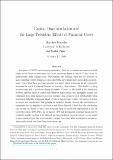Capital deaccumulation and the large persistent effects of financial crises
Abstract
In a panel of OECD and emerging economies, I find that banking crises are characterized by larger initial drops in investment than other large recessions and are followed by particularly persistent drops in output. Furthermore, the larger the drop in investment during the crisis, the more persistent the decrease in output subsequently. I present a model to account for these patterns, in which a financial shock temporarily increases the costs of external finance for investing entrepreneurs, leading to a drop in investment and a persistent slump in output and employment. Critical to the model is the distinction between different types of capital with different depreciation rates. Intangible capital and equipment have high depreciation rates, leading these stocks to drop substantially when investment falls during a financial shock. This can cause output and employment to remain low for close to a decade, through the contribution of equipment and intangibles to production and labor demand. I show that the consequences of such a financial shock correspond to several features of the US Great Recession (2008-2014), especially the large drop in equipment and intangible capital. In the model, TFP and government spending shocks do not lead to such large declines in investment or persistent output decreases, so the model is also consistent with the more transitory output drops seen after non-financial recessions, where such shocks may have been more important.
Citation
Knowles , M P 2015 ' Capital deaccumulation and the large persistent effects of financial crises ' .
Type
Working or discussion paper
Rights
Copyright (c)2015 the author
Collections
Items in the St Andrews Research Repository are protected by copyright, with all rights reserved, unless otherwise indicated.

